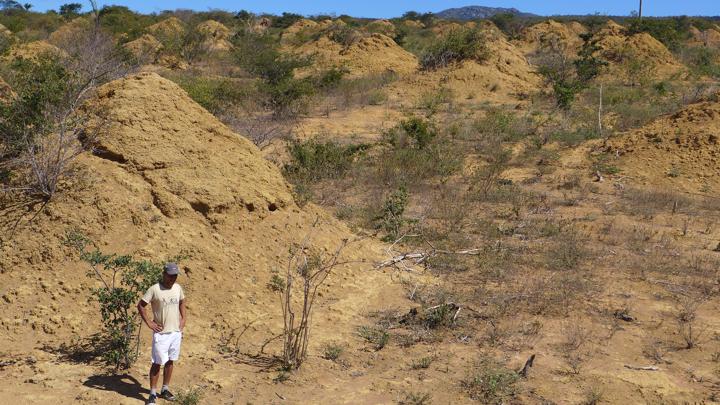Another 'Biological Wonder'
"After 20 minutes, we were still driving through these [large mounds located in northern Brazil], and I started saying, 'Well, what are they'?"
"As humans, we have never built a city that big, anywhere."
"These termites live on dead leaves, and they get to feed once a year."
"The first time I was there, it's just unbelievable. You just cannot believe what you're looking at. What's strange is they're really regularly spaced, as if there was a grand plan."
"They're actually the oldest living structures … made by insects and actually still occupied today, around about 4,000 years."
"These mounds were formed by a single termite species that excavated a massive network of tunnels to allow them to access dead leaves to eat safely and directly from the forest floor."
"It's incredible that, in this day and age, you can find an 'unknown' biological wonder of this sheer size and age still existing, with the occupants still present."
Stephen J. Martin, entomologist, University of Salford, Britain
 |
"[When termites build], the individual termite receives little signals from the other termites."
"It puts a ball of dirt down, and then when 100 million other balls of dirt are down, you suddenly have a mound."
"There are lots of different kinds of termite mounds. Some of them actually keep the termites cool during the day, and a little bit warmer at night."
"There's a lot to love about the termites, I think."
Lisa Margonell, science journalist
"This is apparently the world's most extensive bioengineering effort by a single insect species." "Perhaps most exciting of all -- the mounds are extremely old -- up to 4,000 years, similar to the ages of the pyramids."
"[They’re just amorphous lumps of soil, with no internal structures. Nothing lives inside them. Instead], they’re just slag piles."
"It used to be all green and brown, but around eight years ago, Google Earth sharpened their [satellite] images, and I could see the mounds that I had known from the ground."
"There’s no doubt that they’re termite-made. I’ve seen termites building the mounds with my own eyes. There’s no engineering involved. They’re just throwing the stuff out."
Roy Funch, ecologist, Universidade Estadual de Feira de Santana, Brazil
 |
| A termite queen, left, and a termite king are displayed at the Chongqing Termite Control Institute, on May 16, 2007 in Chongqing Municipality, China. (China Photos/Getty Images) |
Then Dr. Martin met a Brazilian ecologist, Roy R. Funch, at State University of Feira de Santana who was busy planning to undertake radioactive dating in a bid to date the age of the mounds. Several years of investigation ensued where the two scientists collaborated on studying the peculiar mounds, each three meters tall, and nine meters wide. They determined that the construction of what they realized from satellite images was 200 million mounds, represented the industry of Syntermes dirus. some of the largest termite species; insects roughly one centimeter in length.
 |
| More than 200 million termite mounds have been discovered in Brazil, spread across an area so vast that they are visible from space. (Submitted by Stephen Martin) |
Tunnel networks are excavated below the earth, the dirt carried up along a central tube to the summit of a mound, and discarded there, enlarging the mound, bit by bit over time. The pattern revolving around the equal spacing of the mounds appeared to result from an inherently efficient spacing of 'garbage' dirt piles. The presence of the mounds has not been known to anyone outside the region, since the area is hidden by scrub forest where temperatures reach 38 degrees Celsius and greater for most months of the year.
In that landscape the trees are scorched by heat, where the landscape turns a temporary green following a limited month-long rainy season after which the foliage falls from the trees and the landscape once again reverts to its desolate, blanched appearance. It is those fallen leaves that represent the termites' food source, available for only a short period. Since the termites are so dependent on that source of food, when the forest is cut, while the mounds remain, the termites move elsewhere, deprived of their food source.
The area occupied by the mounds is hot and dry, unsuitable for agrarian purposes, though locals did make an effort to try to grow crops there, and failed. A part of the forest was cleared and it was hoped the ensuing field would be able to bear a crop; to no avail. When the two scientists investigated below the surface they discovered layers of 'galleries' where there was storage room for old leaves, and they could see nurseries where young termites were being nurtured to maturity.
 |
| Researcher Stephen Martin, bottom, stands next to a cross-section of one of the massive dirt mounds built by termites in northeastern Brazil. (Submitted by Stephen Martin) |
Labels: Bioscience, Brazil, Ecology, Entomology, Research

0 Comments:
Post a Comment
<< Home